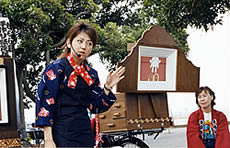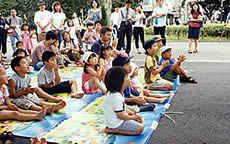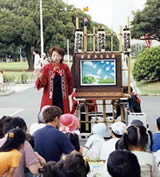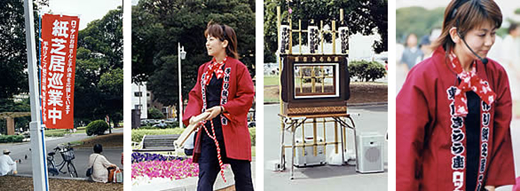Vol.12
A volunteer kamishibai paper theater troupe, known as the "Tokyo Kirara-za" in Higashi-kurume, Tokyo
- A tiny street theater, nostalgic for the past yet full of fresh ideas, where there is face-to-face interaction with children -
A volunteer kamishibai paper theater troupe, known as the "Tokyo Kirara-za" in Higashi-kurume, Tokyo

Today is a holiday ... a theater opens in a sunny park.The audience is made up of children seated on a mat.
Next moment they are spellbound by the storyteller's thrilling voice.
and fascinated by a series of colorful scenes in a small wooden frame.As the story unfolds, their eyes sparkle and they laugh and cheer.
A warm atmosphere seems to waft out from this handcrafted theater.
Some decades have already passed since "kamishibai" picture story shows for children disappeared from street corners and parks. Kamishibai used to be a popular form of children's entertainment and was performed throughout Japan. Much attention is now focused on the Tokyo Kirara-za, a volunteer kamishbai theater group, which brings fresh zest to the traditional kamishibai form. The storyteller's live voice creates a sense of immediate excitement for the audience, something which they would never experience from TV or other modern media. Kamishibai, handmade from simple materials, seems to appeal to the yearning of many people today for a time when life moved at a gentler pace, and may be one of the newest trends in entertainment.

Click-clack...
Beating clappers, a man would appear in a local park with a candy box mounted on the back of his large bicycle. As he told a story in his deep, story-teller's voice against a background of changing pictures, excited children roared with laughter. How many people today can remember such a scene?
Kamishibai is said to have become popular in the mid 1920s as street entertainment for children. Around 1960, kamishibai began to disappear from the streets for several reasons: the spread of TV, the aging of performers, regulations on the use of roads, and the growing tendency among children not to play outdoors. Is kamishibai now a relic of the past? No. Thanks to volunteer citizens' constant efforts, kamishibai has risen from the ashes with renewed energy.

"The show is about to start. A new animated story. Come and see, everybody!" The cheerful voice which announces the start of the show reverberates round the park. As in the old days, a beautiful woodwork candy box on the carrier of the bicycle serves as the theater stage. The storyteller is a young woman dressed up in festive attire. Using hand and body gestures, she talks to children through a headset microphone. In a holiday mood, the little spectators watch the stage in breathless anticipation of what is to happen next. The storyteller sets up her theater. The show begins with a hand-painted picture of a rabbit in pastel colors.

"What do you think there is in this rabbit's tummy? Yes! She's going to have babies!"
The stories performed by this female volunteer group are written and illustrated by its leader. The stories are intended not only to entertain the audience but also to convey a message. While the storyteller vividly impersonates the various characters in the story, she sometimes ad-libs and holds comic dialogues with the audience. The audience gradually become swept into this world of fantasy.
Answering questions from the storyteller, the children help the story along. Both storyteller and audience share in the thrill of the unfolding story and enjoy the happy atmosphere. They begin to associate the relation between the mother and baby rabbits in the story with that between the parents and children gathered round.

The next story follows without a break. This story is about a family of raindrops. As they listen to the adventures of the members of the raindrop family, the audience realize that the source of the water they use everyday is rain. The story educates as it entertains. The one-hour show is over before the audience know it. All the people present, both children and grown-ups, find themselves smiling. They feel that the hour they have just spent was something precious.
The Tokyo Kirara-za's kamishibai may be simple and unsophisticated in comparison with an animation on a large TV screen, but the lively give-and-take between performer and audience could never be achieved by any other medium.